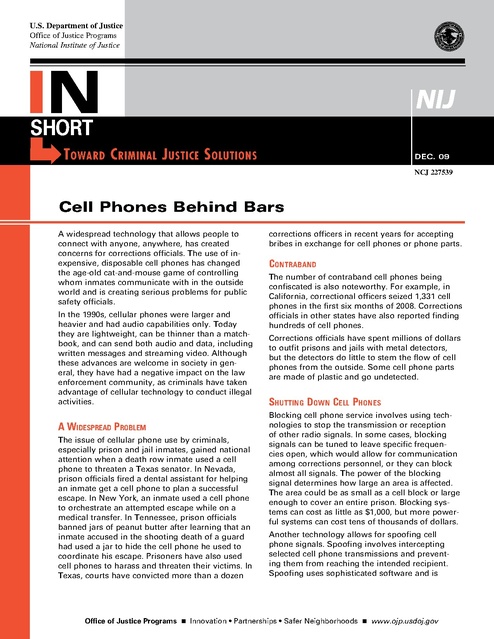Nij Short Prison Cell Phone Report 2009
Download original document:

Document text

Document text
This text is machine-read, and may contain errors. Check the original document to verify accuracy.
U.S. Department of Justice Office of Justice Programs National Institute of Justice IN short T oward C riminal J usTiCe s oluTions DEC. 09 NCJ 227539 Cell Phones Behind Bars A widespread technology that allows people to connect with anyone, anywhere, has created concerns for corrections officials. The use of inexpensive, disposable cell phones has changed the age-old cat-and-mouse game of controlling whom inmates communicate with in the outside world and is creating serious problems for public safety officials. In the 1990s, cellular phones were larger and heavier and had audio capabilities only. Today they are lightweight, can be thinner than a matchbook, and can send both audio and data, including written messages and streaming video. Although these advances are welcome in society in general, they have had a negative impact on the law enforcement community, as criminals have taken advantage of cellular technology to conduct illegal activities. A WidespreAd problem The issue of cellular phone use by criminals, especially prison and jail inmates, gained national attention when a death row inmate used a cell phone to threaten a Texas senator. In Nevada, prison officials fired a dental assistant for helping an inmate get a cell phone to plan a successful escape. In New York, an inmate used a cell phone to orchestrate an attempted escape while on a medical transfer. In Tennessee, prison officials banned jars of peanut butter after learning that an inmate accused in the shooting death of a guard had used a jar to hide the cell phone he used to coordinate his escape. Prisoners have also used cell phones to harass and threaten their victims. In Texas, courts have convicted more than a dozen Office of Justice Programs n corrections officers in recent years for accepting bribes in exchange for cell phones or phone parts. ContrAbAnd The number of contraband cell phones being confiscated is also noteworthy. For example, in California, correctional officers seized 1,331 cell phones in the first six months of 2008. Corrections officials in other states have also reported finding hundreds of cell phones. Corrections officials have spent millions of dollars to outfit prisons and jails with metal detectors, but the detectors do little to stem the flow of cell phones from the outside. Some cell phone parts are made of plastic and go undetected. shutting doWn Cell phones Blocking cell phone service involves using technologies to stop the transmission or reception of other radio signals. In some cases, blocking signals can be tuned to leave specific frequencies open, which would allow for communication among corrections personnel, or they can block almost all signals. The power of the blocking signal determines how large an area is affected. The area could be as small as a cell block or large enough to cover an entire prison. Blocking systems can cost as little as $1,000, but more powerful systems can cost tens of thousands of dollars. Another technology allows for spoofing cell phone signals. Spoofing involves intercepting selected cell phone transmissions and preventing them from reaching the intended recipient. Spoofing uses sophisticated software and is Innovation • Partnerships • Safer Neighborhoods n www.ojp.usdoj.gov 2 possible without the active participation of the cell phone network providers. A drawback to selective blocking and spoofing is the potential for inmates to use approved cell phones that belong to staff members. FederAl government rules The Communications Act of 1934 and the Telecommunications Act of 1996 prohibit the operation of cell-phone-jamming equipment by any person, including state and local officials. Specifically, Section 333 of the Communications Act prohibits willful or malicious interference with any licensed or authorized radio communications equipment or with radio equipment operated by the United States government. In addition, the Act prohibits the manufacture, importation, marketing, sale or operation of devices deliberately designed to jam or disrupt wireless communications. Legislation in Congress titled the Safe Prisons Communications Act of 2009 would let prisons and jails use cell-phone-jamming technology. Countering the problem As they await legislative relief from the problem, corrections officials are using various technologies that detect and find cell phones. Both high-technology and low-technology approaches are being tested and used. Several agencies have installed sensors that detect and find cell phones when in use. One such device tested in a Pennsylvania prison signaled cell phone location to within four cells on two tiers. Some sensors can even detect cell phones that are turned off, but they only work when in close proximity to a phone, cost between $15,000 and $20,000, and require trained staff. Others use new detectors that can identify nonmetallic objects to conduct searches. For smaller facilities, the use of specially formulated paints and coatings that block radio frequency signals may help. Some correctional institutions use specially trained dogs to sniff out hidden cell phones. These efforts have not been rigorously evaluated. Dog training can cost tens of thousands of dollars. Dogs must be close to the phone, and anecdotal evidence suggests that the phone must be left in the same place for a considerable time to be found. Most of these solutions are expensive and labor intensive. Each would benefit from a thorough evaluation. For more information about NIJ’s Communications Technology program, see http://www.ojp.usdoj.gov/ nij/topics/technology/communication/welcome.htm. *NCJ~227539* This document is not intended to create, does not create, and may not be relied upon to create any rights, substantive or procedural, enforceable at law by any party in any matter civil or criminal. Opinions or points of view expressed in this document represent a consensus of the authors and do not necessarily represent the official position or policies of the U.S. Department of Justice. The products and manufacturers discussed in this document are presented for informational purposes only and do not constitute product approval or endorsement by the U.S. Department of Justice.





